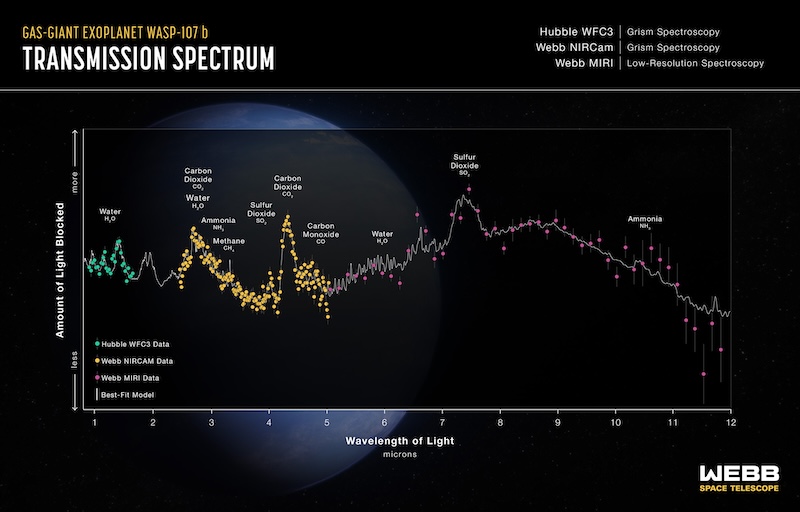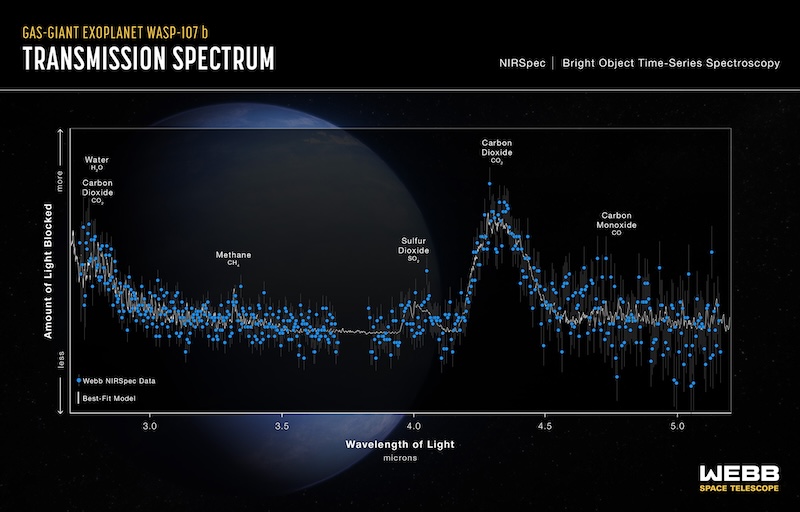- WASP-107 b is a gas giant exoplanet, one of the lightest and least-dense ever discovered. Astronomers have wondered why it’s so “puffy.”
- Two research teams used new data from the James Webb Space Telescope, plus older data from the Hubble Space Telescope, to solve the mystery. These are also the first detailed measurements of an exoplanet’s interior.
- They found the planet has much less methane in its atmosphere than previously thought. This evidence suggests WASP-107 b is hotter on the inside and has a larger core than expected. Tidal heating is thought to cause the excess heat, which explains the planet’s marshmallow-like puffiness.
Solving the mystery of a puffy exoplanet
WASP-107 b is one of the lightest and least dense exoplanets ever discovered. Scientists liken it to a huge, puffy marshmallow. But why is it so puffy? It’s not the only such puffy exoplanet astronomers have found, but most of them are hotter overall and more massive. On May 20, 2024, two teams of researchers said they analyzed data from the James Webb Space Telescope, along with previous data from the Hubble Space Telescope, and found the planet must be much hotter on the inside, with a more massive core, than previously thought. Tidal heating is the likely cause of the excess heat, and surprisingly low levels of methane provided the clues.
The researchers published two new peer-reviewed studies in Nature on May 20, 2024. You can read them here and here.
Observing an unusual puffy exoplanet with Webb
The researchers used a method called transmission spectroscopy – analyzing light that’s passed through a planet’s atmosphere – to study WASP-107 b with Webb. They used Webb’s Near-Infrared Camera (NIRCam) and Mid-Infrared Instrument (MIRI), as well as previous data from Hubble’s Wide Field Camera 3 (WFC3). The first research team, led by Luis Welbanks at Arizona State University, built a broad spectrum of 0.8- to 12.2-micron light absorbed by WASP-107 b’s atmosphere.
The second team, led by David Sing at Johns Hopkins University, likewise built an independent spectrum covering 2.7 to 5.2 microns.
WASP-107 b, 210 light-years away, is about 3/4 the size of Jupiter, but only 1/10 the mass. Its low density and cooler-than-usual temperature makes it an ideal target for Webb. Sing said:
WASP-107 b is such an interesting target for Webb because it’s significantly cooler and more Neptune-like in mass than many of the other low-density planets, the hot Jupiters, we’ve been studying. As a result, we should be able to detect methane and other molecules that can give us information about its chemistry and internal dynamics that we can’t get from a hotter planet.
Why is WASP-107 b so puffy?
The planet’s puffiness has puzzled astronomers. There are other “inflated” exoplanets like this, but WASP-107 b’s characteristics seemed to be different from most of those. Most puffy worlds are hotter and more massive. So how to explain WASP-107 b? Welbanks said:
Based on its radius, mass, age and assumed internal temperature, we thought WASP-107 b had a very small, rocky core surrounded by a huge mass of hydrogen and helium. But it was hard to understand how such a small core could sweep up so much gas, and then stop short of growing fully into a Jupiter-mass planet.
What if the planet instead had a larger core? In that case, the researchers said, the atmosphere should have gradually contracted, not expanded, as it cooled down after the planet first formed. In addition, the planet itself should also be smaller. That’s because there wasn’t enough heat from its star to expand the gases in the atmosphere. This is despite the fact that WASP-107 b orbits very close to its star, at a distance of only 5 million miles, or 1/7 the distance between Mercury and the sun.

Surprising results from Webb
Webb’s measurements of WASP-107 b were extremely precise. The telescope could detect water vapor, methane, carbon dioxide, carbon monoxide, sulfur dioxide and ammonia in the planet’s atmosphere. But what did Webb actually find?
The two sets of spectra from the two teams revealed something unexpected. There was much less methane in the atmosphere than scientists thought there would be. In fact, they found only about 1/1000 of the expected amount. Sing said:
We want to look at planets more similar to the gas giants in our own solar system, which have a lot of methane in their atmospheres. This is where the story of WASP-107 b got really interesting, because we didn’t know why the methane levels were so low.
The low levels of methane indicated that the planet’s interior is hotter than previously thought. Sing said:
This is evidence that hot gas from deep in the planet must be mixing vigorously with the cooler layers higher up. Methane is unstable at high temperatures. The fact that we detected so little, even though we did detect other carbon-bearing molecules, tells us that the interior of the planet must be significantly hotter than we thought.
Zafar Rustamkulov at Johns Hopkins University added:
We think this heat is causing the chemistry of the gases to change, specifically destroying methane and making elevated amounts of carbon dioxide and carbon monoxide.
Tidal heating can explain puffy exoplanet WASP-107 b
So where is the heat coming from? The researchers said tidal heating is the likely cause. WASP-107 b has a slightly elliptical orbit instead of circular. So the gravitational pull of the star is greater when the planet is closer and less when the planet is farther away. This causes the planet’s interior to stretch a bit, heating it in the process.
This data, in turn, allowed the researchers to better estimate the size of WASP-107 b’s core. Daniel Thorngren at Johns Hopkins University explained:
If we know how much energy is in the planet, and we know what proportion of the planet is heavier elements like carbon, nitrogen, oxygen and sulfur, versus how much is hydrogen and helium, we can calculate how much mass must be in the core.
Sing also said:
Looking into the interior of a planet hundreds of light-years away sounds almost impossible, but when you know the mass, radius, atmospheric composition and hotness of its interior, you’ve got all the pieces you need to get an idea of what’s inside and how heavy that core is. This is now something we can do for lots of different gas planets in various systems.

Not so unusual after all
The results indicated that WASP-107 b wasn’t quite as unusual or different from other puffy exoplanets after all. Basically, the core must be twice as massive as previously calculated. This means that WASP-107 b didn’t need to form in some unusual way compared to other known puffy exoplanets. It just required higher temperatures. As Michael Line at Arizona State University noted:
The Webb data tells us that planets like WASP-107 b didn’t have to form in some odd way with a super small core and a huge gassy envelope. Instead, we can take something more like Neptune, with a lot of rock and not as much gas, just dial up the temperature, and poof it up to look the way it does.
Bottom line: Why does the puffy exoplanet WASP-107 b have a density similar to a marshmallow? New findings from Webb show it is hot on the inside due to tidal heating.
Sources:
A high internal heat flux and large core in a warm neptune exoplanet
Preprint: A High Internal Heat Flux and Large Core in a Warm Neptune Exoplanet
A warm Neptune’s methane reveals core mass and vigorous atmospheric mixing
Preprint: A warm Neptune’s methane reveals core mass and vigorous atmospheric mixing
Via STScI
Via Johns Hopkins University
Read more: ‘Super-puff’ exoplanets are like cosmic cotton candy
Read more: What if super-puff planets have rings?